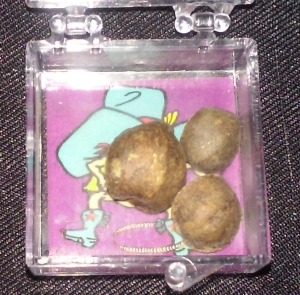In reality, Mexican Jumping Beans are not beans at all; they are seed pods of a shrub found along the rocky slopes of Sonora and Chihuahua, Mexico. Each spring, Cydia deshaisiana or as it is more commonly known the Jumping Bean Moth lays eggs on the seed pods of the shrub. Upon hatching, the larva chews its way into the seed pod where it attaches itself to the inside with silken threads. The larva consumes the interior portion of the seed, which prevents the seed from forming a new shrub when the pods drop to the ground allowing the larva to maintain its residence in hopes of reaching adulthood. Although theories on the movement of the jumping beans all indicate that the movement is caused by larva in one way or another having spasms which causes it to hit against the seed pod causing the “jumping” motion. In reality, the motion from the exterior appears as more of a rocking or tilting motion than an out right jump. A majority of the same theories indicate that it is believed that the larva are actually trying to move the seed pod to a cooler area as the movement often seems related to increased temperatures either on the ground where they fall naturally or when placed in the palm of a warm hand. Regardless, the larva reaching their pupa stage requires adequate moisture and other common factors in order to survive. Around February the surviving larvae prepare themselves for adulthood by gnawing a small hole for access to the exterior which they then cover with silken threads before they enter the pupa stage. This so called trap door is to allow the adult moth a means of escape from the seed pod when they emerge. Adults are small grayish colored moths and have a lifespan of only a few days.
